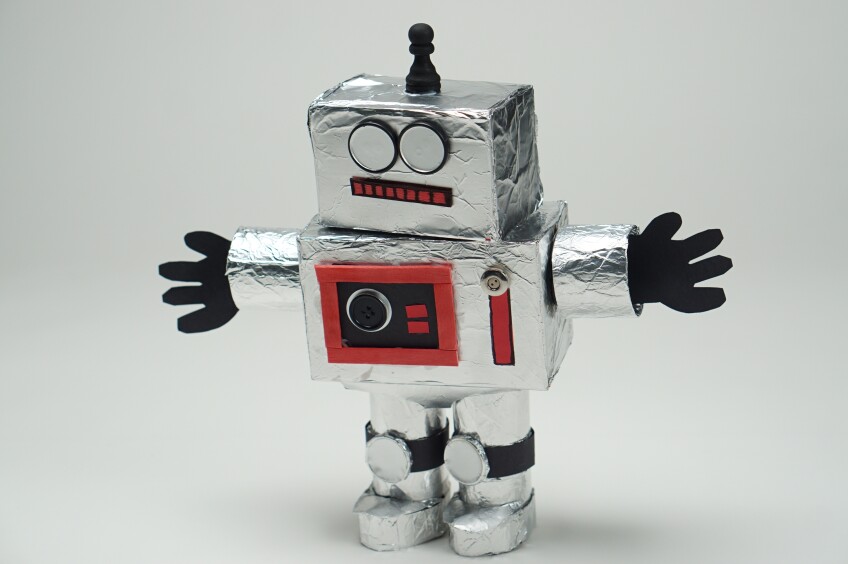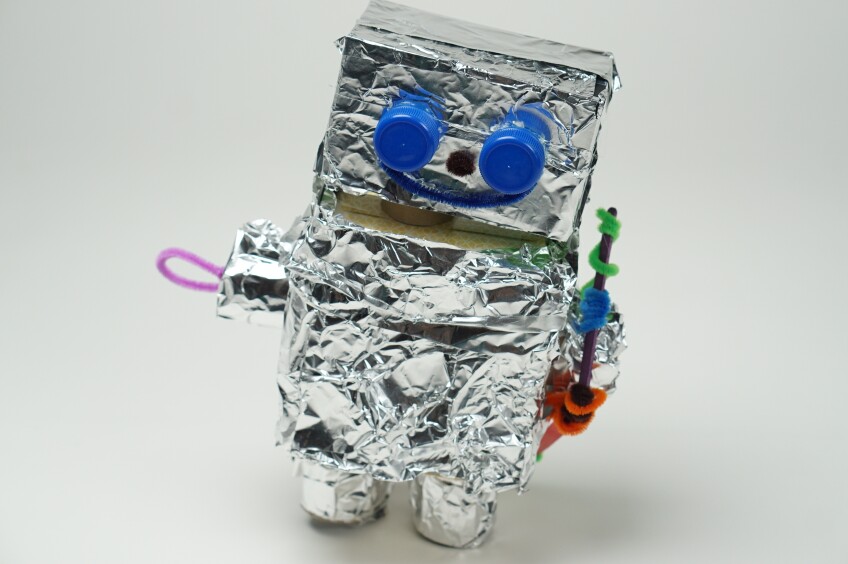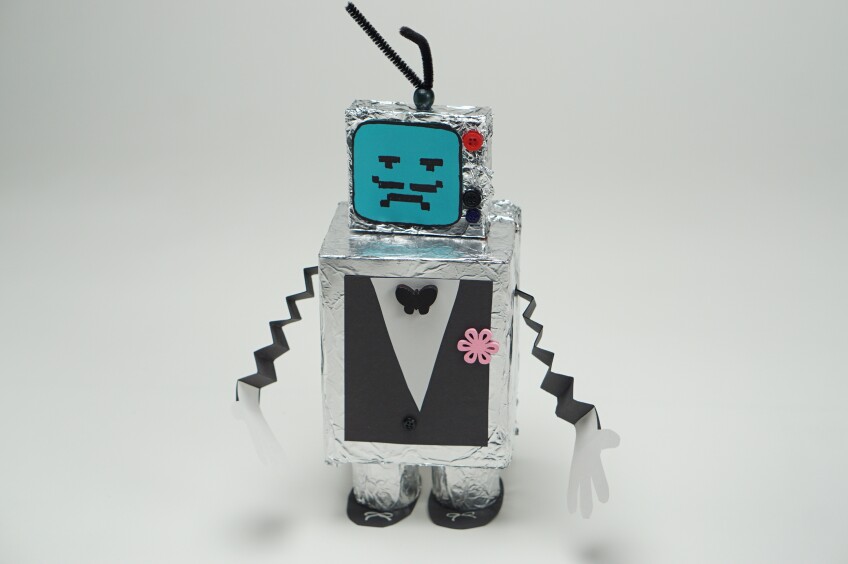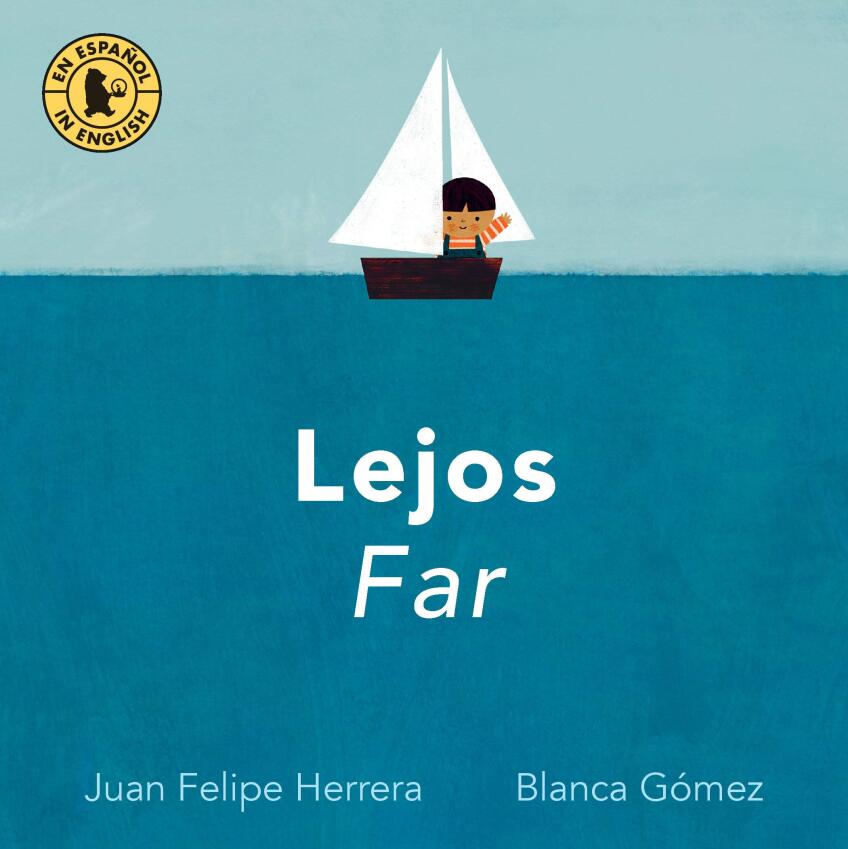Craft Shiny Robots and Spaceships
Spatial relations are the words we use to describe where something is in physical space or in relation to another thing. They’re also known as location and position words and are part of the math skill known as spatial sense. For example, you can describe the position of your hand in relation to the table by saying your hand is “above” the table. It can also be below or next to the table. Spatial words can also describe how things move. For example, your hand can move left, right, up and down. Lastly, spatial words can describe the features of an object. For example, you might say that a building is tall, short, wide or curved.
Fun Fact: Did you know that directional words look different in Spanish than in English? For example, “en” is both “in” and “on.” And Spanish is “verb-framed,” and the verb itself connotes the direction like “subir.” However, English is what is called “satellite-framed.” For example, move is a verb, but “up” gives the direction.
Crafting is a wonderful opportunity for your child to practice using these words, and robots help make it even more fun!
In this activity, you and your child will build a robot and spaceship using boxes and aluminum foil while using location and position words to develop your child's spatial sense.
Before starting the activity, gather an assortment of recycled materials from around the house. For example, paper towel or toilet paper tubes and empty juice boxes make great robot bodies. Empty yogurt cups, empty makeup boxes and balls of aluminum foil make great robot heads. Tissue boxes, cardboard boxes and shoeboxes make great spaceships. Smaller items like bottle caps can make great decorations.
Learning Goals
In this activity, your child will:
- Use spatial and directional words to describe where an object is in space or in relation to another object.
- Apply their understanding of spatial relationships to a structure and make goals, plans and adjustments based on this understanding.
- Use storytelling to practice using spatial and directional words in a sentence.
Vocabulary
- Spatial relations are words used to describe where an object is in space or in relation to another object. Spatial words can describe the features of objects in space (e.g., curvy, tall) as well as where objects are in position to one another (e.g., next to, to the left of, above) or how things move (e.g., up, down, out). For example, the chair is above the floor and underneath the table.
Materials
- Aluminum foil
- Recycled materials to make a robot such as paper towel or toilet paper tubes and/or other empty containers like juice boxes or yogurt cups
- A cereal box, shoebox, or tissue box
- Decorations such as construction paper, googly eyes, pipe cleaners, buttons, bottle caps, etc.
- Tape or glue
- Scissors
Step-by-Step Instructions
Build the robot. It can also be a person, dog, alien, etc. If your child is more excited to build another object to be the center of your space story, encourage them to use their creativity and build whatever they want.
1. When building something new, it helps to start with a goal. Before starting on this out-of-this-world project, talk with your child to plan your build. You can start by laying out all the recycled materials. What items will your child use to build the robot? How will they arrange them?
2. Find two separate objects for the head and body of your robot. Encourage your child to move the pieces around to make a robot. Ask questions that use spatial words like, “Should this piece go above or below the other one?” “Should this long paper tube go up and down or be laid on its side?”
Next, lay out sheets of aluminum foil for your child to wrap the items with. This is great fine motor skill practice for young children, and it’s fun!
3. Now, start to assemble your robot. First, connect the head to the body using tape or glue. As you put your robot together, you may find that the materials don’t fit together like you first planned, so make sure your child knows that it’s okay to revisit and change plans!
4. Decide on decorations like robot arms, legs, buttons and antennas. Then, attach them with tape or glue. Some ideas for decorations are googly eyes, buttons, construction paper shapes and pipe cleaners. Get creative! For example, instead of legs, you can make wheels using bottle caps. Strips of paper folded accordion-style make great arms and legs, and making them is another great opportunity to talk about spatial directions as you fold up and down. You can also use spatial terms to talk about ways to bend the pipe cleaners to make creative antennas designs. For example, you can coil a pipe cleaner by wrapping it around a pen! Ask your child what other ways they can bend a pipe cleaner to come up with a new design (use spatial words like around, left/right and up/down).








Make the spaceship.
5. Next, come up with a plan for building the spaceship together. Start by choosing a goal for the spaceship like tall/short, wide/thin or straight/curved. This will change what materials you will use to build it. For older children, searching around the house for materials to make a curved spaceship is a great challenge. An empty Tupperware container makes a great shell, for example. For simple spaceship designs, you can use an empty box (like a cereal box or shoebox) as the base of your spaceship. Ask your child to draw any shapes that should be cut out, like windows or doors, and help them cut if needed.
6. Now ask your child to add a layer of foil around the ship. You may need to use tape or glue to keep the foil in place.
7. Decorate your shiny spaceship with decorations like bottle caps, construction paper, pipe cleaners, stickers, or any other materials you have around the house. For older children, you can encourage them to draw a picture of what their spaceship should look like before starting to build — just like the blueprints that engineers make before they build something new! Will it have wings? A pointy nose cone? Something else?
Tell a story.
8. It’s time for your child to play with their shiny new toys and create a story using spatial words. Encourage your child to act out the story using the robot and spaceship you made together. It’s okay to start by making up your own story as an example for your child to follow. Place the robot inside the spaceship and ask for your child to come up with a story to explain why the spaceship is moving:
- Forward/backward (e.g., Is another spaceship chasing yours?)
- Up/down (e.g., Is there a planet below that the robot wants to land on and explore?)
- To the left/right (e.g., Is the spaceship moving to dodge a meteorite?)
9. Next, ask your child to come up with a story using spatial words to describe where the robot is in relation to the spaceship. Can you come up with a story that tells why the robot is:
- Inside/outside the spaceship?
- On top of/below the spaceship?
- Far away/near to the spaceship?
Other spatial words:
- under/over/on
- above/below
- behind/in front of
- to the right/left
- beside/around/next to
- across/diagonal from
- close/near/far
Keep the Conversation Going
- Carry over spatial words to other areas of your child’s play. Ask them to share a story with you about the placement of their toys. Why is this car far from that one? Why is the smaller bear in front of the larger one?
- Clean-up time is an excellent opportunity for using spatial words! Use spatial words like behind, under, over and below to describe which item needs to be put away. Use words like in, above and next to describe where the item belongs. For example, “Can you pick up your shoe that is under the couch and put it in the closet next to your other shoes?”
Book Suggestions
“Lejos / Far” (Ages 2-5)
Written Juan Felipe Herrera and illustrated by Blanca Gómez

Corresponding Standards
Math Standards
California Preschool Learning Foundations
- Geometry 2.0: Children expand their understanding of positions in space. .
- 2.1 Identify positions of objects and people in space, such as in/on/under, up/down, inside/outside, beside/between, and in front/behind.
Head Start Early Learning Outcomes Framework
- Goal P-MATH 10. Child explores the positions of objects in space.
Literacy Standards
California Preschool Learning Foundations
- Language Use and Convention 1.0: Children extend their understanding and usage of language to communicate with others effectively.
- 1.4 Use language to construct extended narratives that are real or fictional.
- Vocabulary 2.0: Children develop age-appropriate vocabulary.
- 2.3 Understand and use both simple and complex words that describe relations between objects.
Head Start Early Learning Outcomes Framework
- Goal P-LIT 4. Child demonstrates an understanding of narrative structure through storytelling/re-telling.
Robot craft inspired by Artsy Momma’s Crafty Recycled Robots – an Invitation to Create




